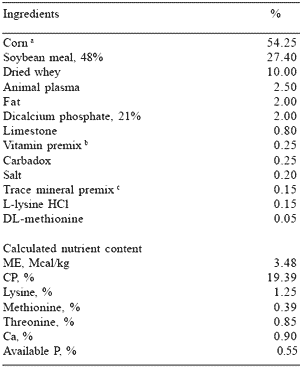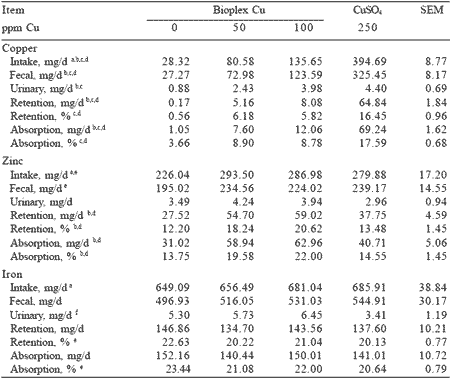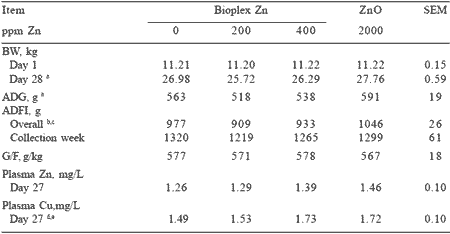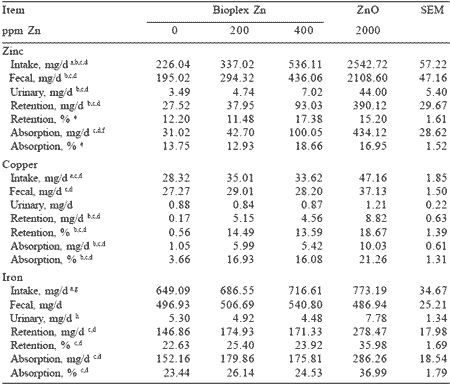Reducing pharmacological levels of copper and zinc in nursery pig diets: response to zinc and copper proteinates
Two 28-day balance experiments were conducted to evaluate mineral excretion by nursery pigs fed lower concentrations of organic copper (Cu) or zinc (Zn) sources (Bioplex Cu or Zn, Alltech Inc., Nicholasville, KY) compared to pharmacological concentrations of inorganic Cu or Zn sources, respectively. Twenty crossbred barrows averaging 11.2 kg were placed in individual pens in each experiment.
For Experiment 1, the four dietary treatments were: (1) Basal diet, (2) Basal + 50 ppm Cu as Cu proteinate (Cu-P), (3) Basal + 100 ppm Cu as Cu-P, and (4) Basal + 250 ppm Cu as copper sulfate (CuSO4). There were no treatment differences (P>0.25) in growth performance criteria. However, plasma Cu increased linearly (P<0.07) in response to increasing dietary Cu-P, and was also higher (P<0.05) for pigs fed CuSO4 compared to the basal diet. Pigs fed increasingly higher levels of Cu as Cu-P had increasing (P<0.01) levels (mg/d) of Cu intake, fecal and urinary excretion, retention, and absorption. Copper intake, fecal and urinary excretion, absorption (mg/d and %) and retention (mg/d and %) were greater (P<0.01) for pigs fed CuSO4 than pigs fed Cu-P or the basal diet. Pigs fed Cu-P had a linear increase (P<0.05) in the retention and absorption (mg/d and %) of Zn, which exceeded that of pigs fed CuSO4 (P<0.01).
For Experiment 2, the four dietary treatments were: (1) Basal diet, (2) Basal + 200 ppm Zn as Zn proteinate (Zn-P), (3) Basal + 400 ppm Zn as Zn-P, and (4) Basal + 2000 ppm Zn as Zn oxide (ZnO). Pigs fed ZnO had higher (P<0.05) day 28 weight and daily gain and higher (P<0.01) daily feed intake compared to pigs fed Zn-P. Pigs fed ZnO had a trend (P<0.08) for higher daily intake than pigs fed the basal diet. Pigs fed Zn-P had a linear increase (P<0.11) in plasma Cu. Pigs fed ZnO had higher (P<0.01) Zn (mg/d) intake, fecal and urinary excretion, absorption and retention compared to pigs fed the basal or the Zn-P diets. For pigs fed Zn-P, there were linear increases in Zn intake, fecal and urinary excretion, and retention (P<0.01 for mg/d and P<0.05 for %). The effects of pharmacological intake of Cu or Zn on plasma concentrations and utilization of Zn and Cu, respectively, and Fe are discussed.
Introduction and objectives
It is well documented that supplementation of weanling pig diets with pharmacological concentrations (125-250 ppm) of Cu as CuSO4 is an effective means to increase growth rate (Bunch et al., 1965; Braude, 1967; Edmonds et al., 1985; Cromwell, 1989). Feeding pharmacological concentrations (2000 to 3000 ppm) of Zn provided by ZnO was found to be an alternative way of increasing nursery pig growth (Hahn and Baker, 1993; Smith et al., 1997; Carlson et al., 1999, Hill et al., 2000). The addition of 3000 ppm Zn from ZnO or 250 ppm Cu from CuSO4 in the nursery diet improved growth rate, however no additive growth response was observed when both Zn and Cu were combined together in the diets (Hill et al., 2000). Feeding pharmacological concentrations of Zn or Cu resulted in a large amount of Zn or Cu excreted, respectively, in swine manure (Apgar and Kornegay, 1996, Hoover et al., 1997). Excessive Zn storage in the soil from pig manure may be toxic to plants and reduce their growth (Chaney, 1993), and may contribute to soil and water pollution. Organic Zn sources such as Zn-lysine and Zn-methionine had higher bioavailabilities than ZnO (Schell and Kornegay, 1996). Thus, using lower concentrations of organic Cu or Zn sources to replace the pharmacological additions of inorganic Cu or Zn, respectively, may reduce Zn or Cu excretion in pig manure. Two experiments were conducted to evaluate lower dietary levels of Cu and Zn proteinates compared to pharmacological levels of CuSO4 and ZnO,respectively, with Cu and Zn balance and fecal excretion as the criteria.
Experiment 1: Effect on Cu excretion of lower levels of dietary Cu proteinate versus pharmacological levels of CuSO4
MATERIALS AND METHODS
In this experiment fecal Cu excretion was evaluated when lower levels of Cu proteinate (Bioplex Cu, Alltech Inc., Nicholasville, KY) were fed compared to 250 ppm Cu from CuSO4. Crossbred barrows were weaned at an average age of 21 days and fed a phase 1 nursery diet containing 22.5% CP, 1.6% lysine and 0.45% methionine that met all NRC (1998) requirements during a 14-day adjustment period. After adjustment, the barrows were weighed; and 20 barrows averaging 11.22 kg were randomly allotted to four dietary treatments for the 28-day experiment. Dietary treatments were: (1) Basal diet containing a trace mineral premix which met or exceeded NRC (1998) requirements, (2) Basal + 50 ppm Cu as Cu proteinate (Cu-P), (3) Basal + 100 ppm Cu as Cu-P, and (4) Basal + 250 ppm Cu as CuSO4. Pigs were housed individually in stainless steel elevated metabolism pens. Each pen was equipped with a nipple waterer and a stainless steel feeder. During the experiment, pigs were fed a phase 2 nursery diet containing 19.4% CP, 1.25% lysine, and 0.40% methionine (Table 1). Chromic oxide (Cr2O3) was added to all diets at 0.05% as a non-digestible indicator. Pigs were fed the diets in meal form twice daily. Pigs had ad libitum access to feed and water at all times. Light was provided from 0600 to 2000, and temperature was maintained at 24 ± 1°C.
Table 1. Percentage composition of basal diets for Experiments 1 and 2.
a In Experiment 1, Cu proteinate (Bioplex Cu) replaced corn to provide 0, 50, and 100 ppm Cu, with a 4th treatment containing 250 ppm Cu as CuSO4. In Experiment 2, Zn proteinate (Bioplex Zn) replaced corn to provide 0, 200, and 400 ppm Zn, with a 4th treatment containing 2000 ppm Zn as ZnO.
b Vitamin premix provided/kg of basal phase 1 and phase 2 diets: 11,000 IU Vitamin A acetate; 1,100 IU Vitamin D3; 44.1 IU vitamin E from dl-"-tocopheryl acetate; 4.0 mg Vitamin K from menadione sodium dimethylpyrimidinol bisulfite; 30.3 mg vitamin B12; 8.3 mg Riboflavin; 28.1 mg pantothenic acid from D-calcium pantothenate; 33.1 mg niacin; 551.3 mg choline from choline chloride; 0.22 mg biotin from d-biotin; 1.65 mg of folic acid.
c Trace mineral premix provided/kg of basal phase 1 and phase 2 diets: 165 mg Zn from ZnSO4; 165 mg Fe from FeSO4; 33 mg Mn from MnSO4; 16.5 mg Cu from CuSO4; 0.3 mg I from Ca(IO3)2; and 0.3 mg Se from Na2SeO3.
On days 1 and 27, individual blood samples were collected from the anterior vena cava of all pigs into 10 ml vacutainer tubes (143 units of sodiumheparin/ tube) and placed on ice. Blood samples were immediately centrifuged at 3000 × g for 10 minutes at 5°C. The separated plasma was stored at -20°C until mineral analysis could be performed. Plasma Cu and Zn concentrations were determined on a flame atomic absorption spectrophotometer after dilution of an aliquot with 10% TCA (trichloroacetic acid) (Varian, 1978).
Feed consumption was recorded weekly and body weight (BW) was measured on day 0 and day 28. Fecal grab samples (about 100 g) and total urine collections were made twice daily (starting at 0800 and 1530) from day 22 to 26 from individual pigs. Urine volume was recorded and a 10 % aliquot was saved. All samples were stored at -20 °C before processing for mineral analysis. After thawing, the fecal samples for individual pigs were pooled, mixed and dried in an oven at 55 °C for 48 hrs then ground to pass a 1mm sieve. Thawed urine samples were pooled for individual pigs. Feed, fecal, and urine samples (2 to 4 g DM) were digested using a mixture of nitric and perchloric acid (AOAC, 1990). Digested fecal, feed and urine samples were diluted to the desired concentration with a mixture of 2% nitric acid and 3% perchloric acid before analysis (Varian, 1978) for Zn, Cu, Fe and Cr as described above for plasma. Water samples were analyzed and found to contain 0.126 mg Cu/L and 0.351 mg Fe/L. Zinc was unreadable. Daily water intake was calculated using the following equation (NRC, 1998): Water intake (L/day) = 0.149 + (3.053 × daily dry feed intake in kg). Estimated daily Cu and Fe intake from water sources averaged 0.5 and 1.40 mg/d.
Data were analyzed (Snedecor and Cochran, 1989) using the GLM procedure of SAS (1989). The statistical model included the effects of added Cu. Individual pigs were the experimental units. Preplanned 1df comparisons were CuSO4 versus the basal diet and CuSO4 versus 50 + 100 ppm Cu-P. Linear effects were tested on the basal plus Cu-P treatments (1df) using orthogonal polynomials.
RESULTS
There were no treatment differences (P>0.25) in day 28 bodyweight gain, daily gain and feed intake or feed efficiency (Table 2). There was no effect of dietary Cu source on plasma Zn level (P>0.35). Plasma Cu level had a linear trend (P<0.07) in response to increasing dietary Cu-P level and was higher (P<0.05) in pigs fed 2000 ppm Cu from CuSO4 compared to the basal diet. As expected, Cu intake increased with increasing dietary Cu-P level (P<0.01) or with CuSO4 compared to both the basal and the Cu-P diets (P<0.01) (Table 3). Fecal and urinary Cu excretion had a linear increase (P<0.01) in response to increasing dietary Cu-P. Fecal excretion of Cu was higher for pigs fed CuSO4 than for pigs fed the basal or Cu-P diets. Urinary excretion of Cu was higher (P<0.01) for pigs fed CuSO4 compared to the basal diet, but was not different from pigs fed the Cu-P diets (P>0.20). Copper absorption and retention (mg/d) increased linearly (P<0.01) with increasing dietary Cu-P. Copper absorption and retention were greater (P<0.01) for pigs fed CuSO4 than for pigs fed Cu-P or the basal diet.
Table 2. Effect of lower concentrations of Cu proteinate on growth performance and plasma concentration of Cu and Zn in nursery pigs (Experiment 1).a
aNo differences for growth performance criteria (P>0.25) or plasma Zn levels (P>0.35).
bLinear trend (P<0.07)in response to Cu as Cu proteinate.
cContrast between CuSO4 and basal diet (P<0.05).
Table 3. Effect of lower concentrations of Cu proteinate on mineral excretion of nursery pigs (Experiment 1).
aIntake = minerals from feed eaten + water consumed.
bLinear increase (P<0.01) in response to Cu as Cu proteinate.
cContrast between CuSO4 and basal diet (P<0.01).
dContrast between CuSO4 and 50 + 100 ppm Cu as Cu proteinate (P<0.01).
eContrast between CuSO4 and basal diet (P<0.05).
fContrast trend between CuSO4 and 50 + 100 ppm Cu as Cu proteinate diets (P<0.09).
Pigs fed CuSO4 had a larger Zn intake than pigs fed the basal diet (P<0.05), but were not different from pigs fed Cu-P (P>0.60). Pigs fed Cu-P had a linear increase (P<0.05) in the retention and absorption (mg/d and %) of Zn. Pigs fed CuSO4 had lower (P<0.01) retention and absorption (mg/d and %) of Zn compared to pigs fed Cu proteinate. Iron intake, absorption, fecal excretion, and retention (mg/d) were not affected (P>0.30) by dietary Cu treatment. There was a trend (P<0.09) for urinary Fe excretion to increase with increasing levels of Cu-P. The absorption and retention (%) of Fe was greater with the basal diet than the diet containing CuSO4 (P<0.05).
Experiment 2: Effect on Zn excretion of lower levels of dietary Zn proteinate versus pharmacological levels of ZnO
MATERIALS AND METHODS
Crossbred barrows were weaned at an average age of 21 days and fed the same phase 1 nursery diet as in Experiment 1 during a 14-day adjustment period. After adjustment, barrows were weighed, and 20 barrows averaging 11.21 kg were randomly allotted to four dietary treatments for the 28-day experiment. Dietary treatments were: (1) Basal diet containing a trace mineral premix, (2) Basal + 200 ppm Zn as Zn proteinate (Zn-P), (3) Basal + 400 ppm Zn as Zn-P, and (4) Basal + 2000 ppm Zn as ZnO. Pigs were individually housed and fed in stainless steel metabolism pens as described for Experiment 1. All management, data collection, data analysis, and statistical procedures were the same as described for the Cu treatments in Experiment 1.
RESULTS
Pigs fed ZnO had higher day 28 bodyweight and daily gain (P<0.05) compared to the pigs fed Zn-P (Table 4). Overall daily feed intake was higher for pigs fed ZnO (P<0.01) compared to pigs fed Zn-P, and pigs fed ZnO tended have a greater (P<0.08) feed consumption than pigs fed the basal diet. There were no treatment differences (P>0.20) in plasma Zn concentrations on day 27. Pigs fed increasing levels of Zn-P had a linear trend for increasing plasma Cu (P<0.11). Pigs fed ZnO also had a trend for higher plasma Cu levels (P<0.13) compared to pigs fed the basal diet. As expected, Zn intake increased with increasing dietary Zn-P level (P<0.01), or with ZnO compared to both the basal and the Zn-P diets (P<0.01) (Table 5). Pigs fed ZnO excreted more (P<0.01) fecal and urinary Zn (mg/d) and absorbed and retained (mg/d) more Zn, compared to pigs fed the basal or the Zn-P diets. Pigs fed increasing levels of Zn-P had a linear increase (P<0.01) in Zn intake, fecal and urinary Zn excretion and Zn retention (mg/ d). There was also a linear increase (P<0.05) in percentage absorption and retention in response to higher Zn-P levels. Pigs fed increasing levels of Zn-P had a trend (P<0.11) for higher Zn absorption (mg/d). Pigs fed ZnO had the highest (P<0.01) Cu intake, fecal excretion, absorption, and retention (mg/d and %) compared to pigs fed the basal diet or Zn-P. Pigs fed increasing retention levels of Zn-P had a linear increase (P<0.01) in Cu absorption and retention (mg/d and %). Pigs fed ZnO had greater Fe absorption and retention and (mg/d and %) than pigs fed either the basal or Zn-P diets (P<0.01). There was a trend (P<0.08) for pigs fed ZnO to have higher urinary Fe excretion than pigs fed Zn-P.
Table 4. Effect of lower concentrations of Zn proteinate on growth performance and plasma concentration of Cu and Zn in nursery pigs (Experiment 2).
aContrast between ZnO and 200 + 400 ppm Zn as Zn proteinate (P<0.05).
bContrast between ZnO and 200 + 400 ppm Zn as Zn proteinate (P<0.01).
cContrast trend between ZnO and basal diet (P<0.08).
dLinear increase trend (P<0.11) in response to Zn as Zn proteinate.
eContrast trend between ZnO and basal diet (P<0.13).<
Discussion
In both experiments, similar growth performance between the basal diet and diets containing pharmacological levels of CuSO4 or ZnO indicate that pigs fed the basal diets were receiving adequate trace mineral nutrition. Pigs fed Cu-P or pharmacological CuSO4 (250 ppm) excreted significantly more Cu in feces and urine, which was expected. Pigs fed 50 ppm Cu as Cu-P or 250 Cu as CuSO4 excreted 73 or 325 mg of fecal Cu/d, respectively, a 4.5-fold increase in the amount of Cu excreted by pigs fed CuSO4. Apgar et al. (1996) reported that 71-kg barrows fed 250 ppm Cu excreted 6.9 times more Cu than pigs fed 36 ppm Cu, from CuSO4. Bowland et al. (1961) reported that pigs fed 250 ppm Cu as CuSO4 excreted 90% as fecal Cu, similar to the excretion rate obtained in this experiment.
Table 5. Effect of lower concentrations of Zn proteinate on mineral excretion of nursery pigs (Experiment 2).
aIntake = minerals from feed eaten + water consumed.
bLinear increase (P<0.01) in response to Zn as Zn proteinate.
cContrast between ZnO and basal diet (P<0.01).
dContrast between ZnO and 200 + 400 ppm Zn as Zn proteinate (P<0.01).
eLinear increase (P<0.05) in response to Zn as Zn proteinate.
fLinear increase trend (P<0.11) in response to Zn as Zn proteinate.
gContrast between ZnO and basal diet (P<0.05).
hContrast trend between ZnO and 200 + 400 ppm Zn as Zn proteinate (P<0.08).
More Cu (mg/d and %) was retained when pigs were fed Cu-P or CuSO4 compared to the basal diet in the present experiment, with pigs fed 250 ppm Cu as CuSO4 having the highest Cu retention (mg/d and %). This supports the report by Castell and Bowland (1968) that the apparent retention of Cu increased when growing-finishing pigs were fed 250 ppm Cu as CuSO4. Roof and Mahan (1982) also reported that pigs fed 250 ppm of Cu as CuSO4 in combination with carbadox absorbed and retained more Cu than pigs fed the basal diet. However, Apgar et al. (1996) reported that finishing pigs fed high levels of CuSO4 or Cu-Lys had similar Cu retention.
Increasing levels of Cu-P linearly increased plasma Cu concentrations equal to those of pigs fed CuSO4, which were higher than the plasma Cu concentrations of pigs fed the basal diet. Pigs fed 50 or 100 ppm Cu as Cu-P had a higher Zn absorption and retention (mg/d and %) than pigs fed the basal diet or the diet containing CuSO4. This suggests that supplementation with Cu-P may improve Zn utilization for nursery pigs. The additionof Cu-P or CuSO4 did not significantly affect Fe excretion or retention in Experiment 1. Gipp et al. (1973) found that pigs fed 250 ppm Cu as CuSO4 developed microcytic hypochromic anemia when the diet contained only 20 ppm Fe as FeSO4. Hedges and Kornegay (1973) reported that the addition of 257 ppm Cu as CuSO4 decreased hemoglobin concentration when the diets contained 101 ppm Fe as FeSO4, but maintained normal hemoglobin concentrations when dietary Fe was increased to 312 ppm. Dove and Haydon (1991) also found the addition of up to 300 ppm Fe as FeSO4 may help to improve the hematological status of weanling pigs fed 250 ppm Cu as CuSO4 for growth promotion. This suggests that dietary Fe may need to be increased to maintain normal hemoglobin when high Cu (250 ppm Cu) is used in the diet. Pigs fed Cu-P did not differ from pigs fed the basal or CuSO4 diets in either absorption or retention (mg/d or %) of Fe; they were intermediate between pigs fed the basal or CuSO4 diets. This suggests that diets with pharmacological levels of Cu from any source should contain adequate Fe when fed to growing pigs.
Pigs fed pharmacological concentrations of Zn (2000 ppm) as ZnO excreted more fecal and urinary Zn and absorbed and retained more Zn in Experiment 2, than all the other treatments. Hoover et al. (1997) reported that pigs fed 3000 ppm Zn as ZnO excreted the most Zn in feces and urine compared to pigs fed the basal diet. The linear trend for an increase in Zn absorption and retention for pigs fed Zn-P indicates that high dietary Zn from organic sources also increases Zn retention. Poulsen and Larsen (1994) reported that Zn retention by growing pigs increased linearly as supplemental ZnO increased up to 0.30 g/d. In our experiment pigs fed 2000 ppm Zn as ZnO absorbed and retained (mg/d and %) more Zn and Fe than pigs fed the other treatments in Experiment 2. Pigs fed Zn-P were intermediate to, and did not differ from, the other treatments in Fe absorption and retention (mg/d and %), suggesting that organic Zn may increase Fe absorption and retention.
Implications
Pigs fed diets containing 250 ppm Cu as CuSO4 or 2000 ppm Zn as ZnO excreted high levels of Cu or Zn, respectively, in feces and urine. Fecal and urinary excretion of Cu and Zn were greatly decreased by feeding lower levels of Cu and Zn proteinate, respectively, compared to feeding pharmacological levels of CuSO4 or ZnO. The use of Cu or Zn proteinate in nursery diets as replacements for pharmacological levels of inorganic Cu or Zn, respectively, would greatly reduce soil and water pollution.
References
Authors: C. WU1, A. TSUNODA1, D.W. BOLLINGER1, M.S. CARLSON1, T.L. VEUM1 and G.W. TIBBETTS2AOAC. 1990. Official Methods of Analysis (15th Ed.). Association of Official Analytical Chemists, Arlington, VA.
Apgar, G.A. and E.T. Kornegay. 1996. Mineral balance of finishing pigs fed copper sulfate or a copper-lysine complex at growth-stimulating levels. J. Anim. Sci. 74:1594-1600.
Bowland, J.O., R. Braude, A.G. Chamberlain, R.F. Glascock and K.G. Mitchell. 1961. The absorption, distribution and excretion of labelled copper in young pigs given different quantities, as sulphate or sulphide, orally or intravenously. Br. J. Nutr. 15:59-72.
Braude, R. 1967. Copper as a stimulant in pig feed (cuprum pro pecunia). World Rev. Anim. Prod. 3:69-82.
Bunch, R.J., J.T. McCall, V.C. Speer and V.W. Hays. 1965. Copper supplementation for weanling pigs. J. Anim. Sci. 24:995-1000.
Carlson, M.S., G.M. Hill and J.E. Link. 1999. Early- and traditionally weaned nursery pigs benefit from phase-feeding pharmacological concentrations of zinc oxide: effect on metallothionein and mineral concentrations. J. Anim. Sci. 77:1199-1207.
Castell, A.G. and J.P. Bowland. 1968. Supplemental copper for swine growth, digestibility and carcass measurement. Can. J. Anim. Sci. 48:403.
Chaney, R.L. 1993. Zinc phytotoxicity. In: Zinc in Soils and Plants. Kluwer Academic Press. Dordrecht, The Netherlands. pp. 135-150.
Cromwell, G.L., T.S. Stahly and H.J. Monegue. 1989. Effects of source and level of copper on performance and liver copper stores in weanling pigs. J. Anim. Sci. 67:2996-3002.
Dove, C.R. and K.D. Haydon. 1991. The effect of copper addition to diets with various iron levels on the performance and hematology of weanling swine. J. Anim. Sci. 69:2013-2019.
Edmonds, M.S., O.A. Izquierdo and D.H. Baker. 1985. Feed additive studies with newly weaned pigs: efficacy of supplemental copper, antibiotics and organic acids. J. Anim. Sci. 60:462-469.
Gipp, W.F., W.G. Pond, J. Tasker, D. Van Campen, L. Krook and W.J. Visek. 1973. Influence of level of dietary copper on weight gain. Hematology and liver copper and iron storage of young pigs. J. Nutr. 103:713-719.
Hahn, J.D. and D.H. Baker. 1993. Growth and plasma zinc responses of young pigs fed pharmacological levels of zinc. J. Anim. Sci. 71:3020- 3024.
Hedges, J.D. and E.T. Kornegay. 1973. Interrelationship of dietary copper and iron as measured by blood parameters, tissue stores and feedlot performance of swine. J. Anim. Sci. 37:1147-1154.
Hill, G.M., G.L. Cromwell, T.D. Crenshaw, C.R. Dove, R.C. Ewan, D.A. Knabe, A.J. Lewis, G.W. Libal, D.C. Mahan, G.C. Shurson, L.L. Southern and T.L. Veum. 2000. Growth promotion effects and plasma changes from feeding high dietary concentrations of zinc and copper to weanling pigs (regional study). J. Anim. Sci. 78:1010-1016.
Hoover, S.L., M.S. Carlson, G.M. Hill, J.E. Link, T.L. Ward and T.M. Fakler. 1997. Evaluation of excretion and retention of zinc from inorganic and organic sources in diets fed to weanling pigs. J. Anim. Sci. 75(Suppl.1):189(Abstr.).
NRC, 1998. Nutrient Requirement of Swine (10th Ed.). National Academy Press. Washington, DC.
Poulsen, H.D. and T. Larsen. 1994. Increasing levels of dietary zinc oxide to young pigs. Effects on zinc retention and excretion. In: W. B. Souffront and H. Hagemeister (Ed.). 11th International Symposium on digestive physiology in pigs. Bad Dobran, Oct. 4-6, pp 133-135.
Roof, M.D. and D.C. Mahan. 1982. Effect of carbadox and various dietary copper levels for weanling swine. J. Anim. Sci. 55:1109-1117.
SAS. 1989. SAS User’s Guide (Release 6.12). SAS Inst. Inc., Cary, NC USA. Snedecor, G.W. and W.G. Cochran. 1989. Statistical Methods (8th Ed.). Iowa State University Press, Ames.
Schell, T.C. and E.T. Kornegay. 1996. Zinc concentration in tissues and performance of weanling pigs fed pharmacological levels of zinc from ZnO, Zn-methionine, Zn-lysine, or ZnSO4. J. Anim. Sci. 74:1584-1593.
Smith, J.W. 2nd, M.D. Tokach, R.D. Goodband, J.L. Nelssen and B.T. Richert. 1997. Effects of the interrelationship between zinc oxide and copper sulfate on growth performance of early-weaned pigs. J. Anim. Sci. 75:1861-1866.
Varian, 1978. Analytical Methods for Flame Spectroscopy. Pub. No. 85- 100009-00 June. Varian Techtron Pty. Ltd., Springvale, Australia.
1 Department of Animal Science, University of Missouri, Columbia
2 Alltech, Inc. Nicolasville, Kentucky





.jpg&w=3840&q=75)